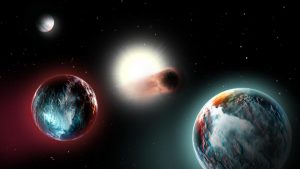
Not every world is habitable, and some worlds are actually under attack by their stars. A new paper appearing in the Monthly Notices of the Royal Astronomical Society gives us one particular example of just how bad it can get. In a study of the 25 million-year-old, Sun-like star V1298, scientists led by Katja Poppenhäger of the Leibniz-Institut Für Astrophysik in Potsdam have documented the horrific x-ray radiation that is blasting four young planets.
Young stars rotate very rapidly, and this rotation drives powerful magnetic fields. As the stars age, a variety of different processes cause them to slow down, which in turn reduces the magnetic field levels. According to this new research, exactly how long that takes can define the fates of worlds. Currently, V1298 is observed to have four large planets – two are Neptune-like and near their star, and two are more Saturn-like and further out. At least this is how they appear today. Using the Chandra X-Ray Observatory, scientists have observed current levels of x-ray emission capable of stripping the planets’ atmospheres away. If these strong magnetic fields and their x-ray emissions last too long, they will reduce the inner planets to lumps of rock, which admittedly could be understood as rocky worlds like Earth or even Mercury. The outermost and largest planet should be able to hold onto its atmosphere, but the fate of the middle gas giant is unknown as its mass still isn’t accurately determined.
This research raises some interesting questions about the horrific childhood of young planets. As stars rage against world atmospheres, they may be able to transform gas giants and ice giants into terrestrial planets. This changes how we view planet formation and may even change how we look at worlds in our own solar system. As we mentioned, V1298 is a sun-like star in the making. Its ice giants could be terrestrial worlds in the making. We don’t know – not yet – but this is the kind of question we need to consider as we try to define how solar systems form.
Understanding solar system formation is one of the most complex problems of interest today, and it requires understanding so much more than just a star and its worlds: it requires understanding the evolution of our universe. Worlds like our own require the clouds of dust and gas our solar system once was to contain all the chemistry required for life. As we’ve often talked about, the universe started out with only hydrogen, helium, and trace amounts of lithium and beryllium. It is through complex nucleosynthesis in stars and in the environments of explosively dying and merging stars, that everything else is formed. That gold you wear? That probably came from a neutron star merger. The platinum inside your cell phone? It may have originated in a supernova. Even the carbon that makes up so much of our body came from regular stars undergoing nuclear reactions in their cores.
More Information
Leibniz Institute for Astrophysics Potsdam press release
“X-ray Irradiation and Evaporation of the Four Young Planets Around V1298 Tau,” K. Poppenhaeger, L. Ketzer & M. Mallonn, 2020 May 30, Monthly Notices of the Royal Astronomical Society (Preprint on arxiv.org)




 Join the Crew!
Join the Crew!
 Escape Velocity Space News
Escape Velocity Space News
0 Comments